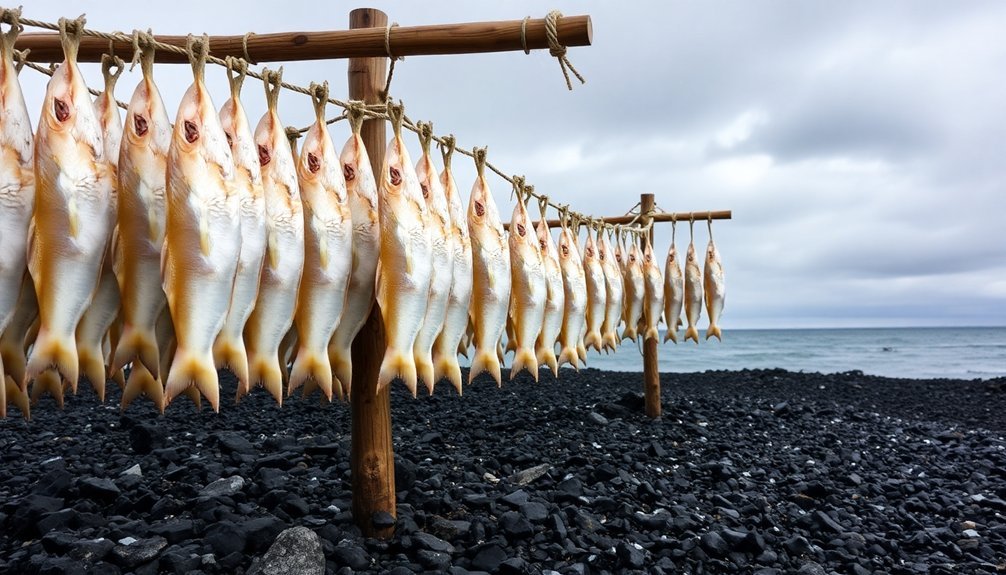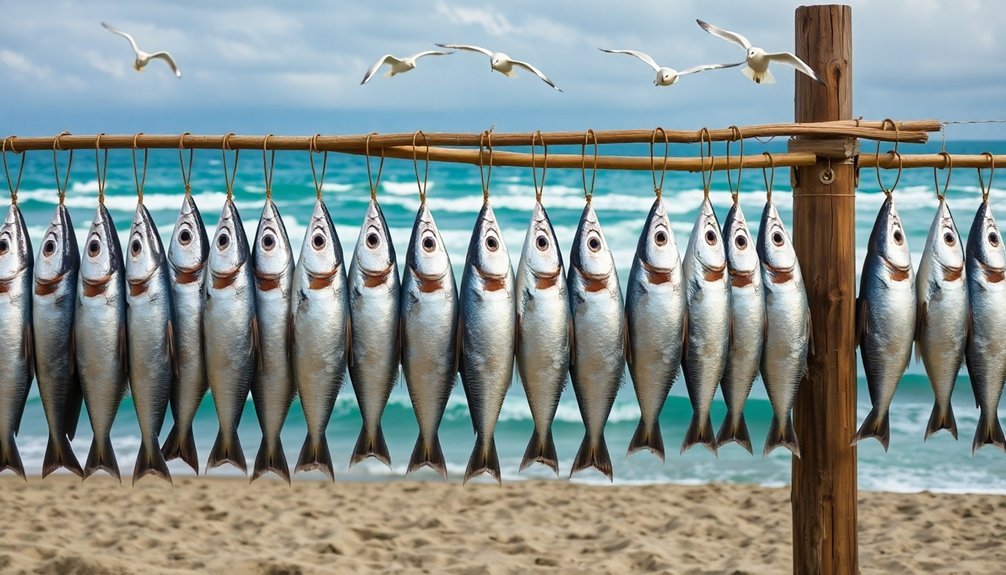You'll find three proven coastal methods to air-dry fish effectively. The traditional Harðfiskur technique involves storing cleaned fish in airtight containers, allowing it to dry while preserving nutrients and omega-3s. Beachfront sun drying utilizes natural elements – you'll need to clean, gut, and fillet the fish before arranging it in single layers, turning every two hours for even drying. The saltwater preservation method combines salt-drying and brining, using salt equal to one-third of the fish's weight for 1-3 days of curing. Each method offers unique benefits, and exploring their variations can reveal exceptional preservation results.
Traditional Harðfiskur Method

Once dried, store your Harðfiskur in airtight containers.
You can eat it as is, or pound it with a mallet for more supple strips.
The result is a protein-rich, omega-3-packed snack that'll keep for months. For optimal results, maintain freshness by ensuring your containers are free from air exposure.
Beachfront Sun Drying
Beachfront sun drying offers a simpler alternative to the Harðfiskur method, requiring only nature's elements to preserve your catch. This traditional preservation technique has been used for centuries in coastal communities worldwide.
You'll need to start by thoroughly cleaning and gutting your fish, removing heads and bones, and filleting the meat into even pieces. Choose lean fish species, as they're less likely to turn rancid during the drying process.
Set up your drying station with mesh racks or bamboo strainers that allow proper airflow while protecting your fish from birds and insects. You'll want to position your racks in direct sunlight, preferably early in the morning, and guarantee there's adequate ventilation throughout the drying area.
For successful beachfront drying, follow these critical steps:
- Arrange filleted fish in single layers, making sure pieces don't overlap.
- Turn the fish every two hours to guarantee even drying on both sides.
- Continue the process until the fish feels like stiff paper and doesn't stick to your finger.
Once your fish is completely dry, you can store it in airtight containers for up to a year.
When you're ready to use it, simply rehydrate by soaking in water or adding directly to soups and stews.
Saltwater Fish Preservation

Through centuries of coastal living, saltwater fish preservation has evolved into several reliable methods that complement air-drying techniques.
When you're preserving saltwater fish, you'll find that salt drying offers a fundamental approach. You'll need to scale and gut the fish, then apply salt equal to about one-third of the fish's weight to both its cavity and exterior. Let it cure for 1-3 days to allow proper moisture extraction. Thorough cleaning is essential to eliminate potential contamination sources.
If you prefer brining, you can submerge your fish in a salt solution. Stack the fish in layers with salt between them, and use a weight to keep them fully submerged. Depending on size, you'll need to cure them for 2-10 days.
For additional flavor, you might want to try smoking your fish at 85-100°F in a smokehouse, which not only preserves but also adds distinctive taste.
You can also pickle your catch in a vinegar solution, which creates an acidic environment that prevents bacterial growth.
Each method works effectively on its own, but you'll get the best results by combining techniques. For instance, you can smoke salt-dried fish or add pickled fish to a brine solution for enhanced preservation.
Frequently Asked Questions
Can I Reuse the Same Drying Rack for Different Types of Fish?
You can reuse drying racks for different fish types, but you'll need to thoroughly clean and sanitize them between uses to prevent cross-contamination. Don't forget to wash with hot water and food-safe disinfectant.
How Do I Protect Drying Fish During Unexpected Rain?
When unexpected rain hits, you'll need to quickly move your drying fish to a covered area. Use waterproof tarps, guarantee good ventilation, and keep monitoring weather conditions until you can resume outdoor drying.
What's the Minimum Distance Needed Between Fish Pieces While Drying?
You'll need to space your fish at least 2-3 inches apart on drying tables or when hanging. This guarantees proper air circulation around each piece and prevents moisture from getting trapped between them.
Does Moonlight Exposure Affect the Drying Process Negatively?
You don't need to worry about moonlight exposure when drying fish. It won't negatively affect the process at all. Focus instead on maintaining good ventilation, proper spacing, and protecting from moisture and rain.
Can I Mix Different Fish Species on the Same Drying Rack?
You shouldn't mix different fish species on the same rack. It's risky because of varying drying times, potential flavor transfer, and increased contamination risks. Instead, group similar-sized fish of the same species together.
In Summary
You'll find these three coastal fish-drying methods work best when you've got the right climate and setup. Whether you choose the Icelandic Harðfiskur technique, beachfront sun drying, or saltwater preservation, remember to keep your fish protected from insects and debris. Each method requires patience, but you'll be rewarded with perfectly preserved fish that maintains its nutritional value and distinctive flavor.





Leave a Reply